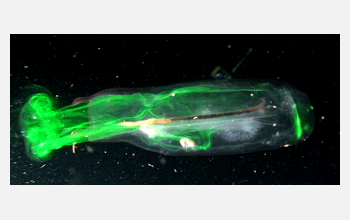Multimedia Gallery
Salp Jet Wake
The image above shows a jet wake produced by the salp Cyclosalpa affinis. Salps, or pelagic tunicates, are relatively common gelatinous organisms in oceanic waters. Salps swim using jet propulsion, drawing water in through an incurrent siphon and ejecting water from an excurrent siphon at opposite ends of the body. The jet wake in the image was made visible using fluorescein dye during a night scuba dive.
More about this Image
Kelly Rakow Sutherland of Woods Hole Oceanographic Institution (WHOI), Alexandra Techet of MIT and Larry Madin of WHOI, are involved in a National Science Foundation-supported study to look at propulsive jet wakes to compare distinct swimming styles among different species of salps.
Salps are pelagic, barrel-shaped, jet-propelled swimmers that have higher filtering rates of small particles (1 m- 1 mm) than almost any other planktonic grazer. The majority of salp species are found in oceanic tropical and subtropical waters where they play a critical role in the cycling of organic material. An understanding of their swimming behavior and filter feeding mechanics is critical to figuring out the ecological role of these important grazers. The coupling of feeding and locomotion by salps during jet propulsion results in trade-offs between these two life processes.
This group of animals is characterized by a diversity of morphology and swimming behaviors that likely relate to ecological roles of co-occurring species. Preliminary data from the study indicate that morphological differences may account for a range of lifestyles among salps, from fast swimming forms to slower swimming forms. Fast swimming salps are characterized by enhanced musculature, higher pulse rates and linear, streamlined chain structures compared to slower, surface oriented salps.
This study will examine the swimming and feeding behavior of salp species that are present off the Pacific Coast of Panama and use the information to draw linkages between morphology, swimming mechanics and ecological roles. The approach will combine field and lab methods ranging in scale from the microscopic filtering apparatus to the flow field around the animal. The work will focus on Salpa cylindrical, a fast-swimming, streamlined salp, Pegea confoederata, a slower swimming salp and Cyclosalpa spp., a slow swimming salp with wheel-shaped aggregates.
Specific goals of the team's research are to a) quantify the flow of water produced by swimming salps in the field and in the lab and examine the connection between flow and feeding efficiency; b) describe the form and movement of the entire filtering mesh with 3-D video; and c) measure filtering mesh parameters microscopically in order to describe the small-scale mechanics of filtration. There is increasing knowledge of the substantial transport of material to the ocean's deep interior by gelatinous grazers, but researchers lack information about the ecological function and relationships of individual species. The application of new techniques will provide a mechanistic basis for variations in filtering rates and particle retention efficiencies among salp species. The work will enhance our understanding of the evolutionary diversity of form present in salps and how it relates more broadly to the coexistence of other planktonic grazers. [Research supported by NSF grant OCE 06-47723, "Form, Function and Flow in the Plankton: Jet Propulsion and Filtration by Pelagic Tunicates"]. (Date of Image: January 2008)
Credit: Kelly Rakow Sutherland, Woods Hole Oceanographic Institution
Images and other media in the National Science Foundation Multimedia Gallery are available for use in print and electronic material by NSF employees, members of the media, university staff, teachers and the general public. All media in the gallery are intended for personal, educational and nonprofit/non-commercial use only.
Images credited to the National Science Foundation, a federal agency, are in the public domain. The images were created by employees of the United States Government as part of their official duties or prepared by contractors as "works for hire" for NSF. You may freely use NSF-credited images and, at your discretion, credit NSF with a "Courtesy: National Science Foundation" notation.
Additional information about general usage can be found in Conditions.
Also Available:
Download the high-resolution TIF version of the image. (3.8 MB)
Use your mouse to right-click (Mac users may need to Ctrl-click) the link above and choose the option that will save the file or target to your computer.

